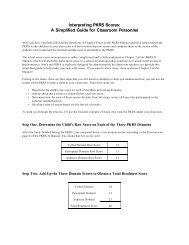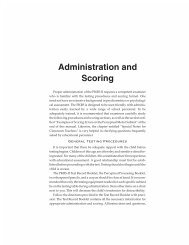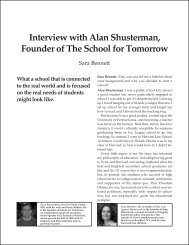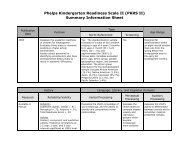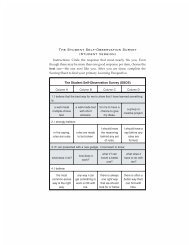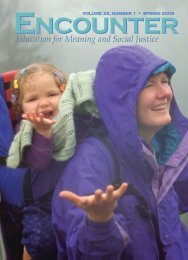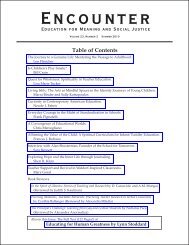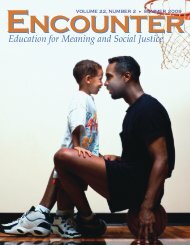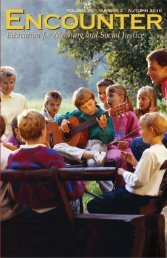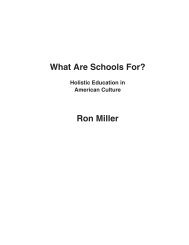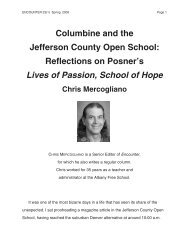Read a the Full Commentary by Lulaellen Pilgrim - Great Ideas in ...
Read a the Full Commentary by Lulaellen Pilgrim - Great Ideas in ...
Read a the Full Commentary by Lulaellen Pilgrim - Great Ideas in ...
- No tags were found...
Create successful ePaper yourself
Turn your PDF publications into a flip-book with our unique Google optimized e-Paper software.
Comments on Stoddard’sEducat<strong>in</strong>g for Human <strong>Great</strong>ness<strong>by</strong> <strong>Lulaellen</strong> <strong>Pilgrim</strong>Many of <strong>the</strong> students who enroll <strong>in</strong> Pacific Oaks college classes arepractitioners <strong>in</strong> <strong>the</strong> field of human development which <strong>in</strong>cludes but isn’tlimited to early childhood education. They teach, lead, facilitate, designprograms, work collaboratively with people <strong>in</strong> o<strong>the</strong>r agencies, problemsolve, assess, plan environments, and o<strong>the</strong>rwise do <strong>the</strong> important workoftentimes com<strong>in</strong>g under <strong>the</strong> umbrella of education. These students attendclass nights, weekends, holidays, and onl<strong>in</strong>e, when <strong>the</strong>y aren’twork<strong>in</strong>g at <strong>the</strong>ir “day job,” to add to <strong>the</strong>ir skills and to ga<strong>in</strong> an advanceddegree <strong>in</strong> <strong>the</strong> field of human development and teacher education.Questions <strong>the</strong>y br<strong>in</strong>g with <strong>the</strong>m and that we try to f<strong>in</strong>d answers todur<strong>in</strong>g <strong>the</strong>ir course of study <strong>in</strong>clude:• How does a teacher ma<strong>in</strong>ta<strong>in</strong> an <strong>in</strong>terest<strong>in</strong>g, supportive, anddevelopmentally appropriate environment that encourageschildren to build on what <strong>the</strong>y know and become enthusiastic,<strong>in</strong>dependent, lifelong learners, when <strong>the</strong> requirements fromfederal and state entities often prescribe and mandate rigid,“same size fits all” curriculum to prepare for tests that now beg<strong>in</strong>as early as three years old?• How do I show a child and her family that I honor, respect, andvalue her language and culture while at <strong>the</strong> same time provid<strong>in</strong>gher with <strong>the</strong> skills and knowledge necessary to be successful <strong>in</strong>this English-speak<strong>in</strong>g society?• Is <strong>the</strong>re an acceptable way to balance a skills-based approachwith a “process is important” approach?• Sometimes I feel like I’m just a pawn for some politician whoth<strong>in</strong>ks he has <strong>the</strong> answer to “why Johnny can’t read,” and that ifhe writes and passes a bill that restricts teachers to us<strong>in</strong>g a“canned” curriculum written <strong>by</strong> a publish<strong>in</strong>g company that islook<strong>in</strong>g for a restrictive environment where only that and
perhaps one o<strong>the</strong>r program is allowed, <strong>the</strong>n, <strong>by</strong> golly, Johnny willlearn to read. Is <strong>the</strong>re a way to make required, restrictivecurriculum palatable?• How do I productively use <strong>the</strong> knowledge, experience andtra<strong>in</strong><strong>in</strong>g I’ve received as a teacher when it doesn’t seemcompatible with <strong>the</strong> requirements of those who manage <strong>the</strong>“purse str<strong>in</strong>gs?”To support students <strong>in</strong> f<strong>in</strong>d<strong>in</strong>g answers to <strong>the</strong>se questions, and o<strong>the</strong>rs,my courses are designed around available resources. Books, articles, media,<strong>the</strong> <strong>in</strong>ternet, lectures, observations, action research, and discussionswith o<strong>the</strong>rs <strong>in</strong> <strong>the</strong> field are all part of <strong>the</strong> course. The students are encouragedto use <strong>the</strong>ir ideas and what <strong>the</strong>y are learn<strong>in</strong>g to collaboratively design<strong>the</strong>ir own programs suited to <strong>the</strong> people with whom <strong>the</strong>y work.Questions and <strong>the</strong> means of f<strong>in</strong>d<strong>in</strong>g answers to those questions are encouraged.<strong>Full</strong> engagement <strong>in</strong> <strong>the</strong> course, responsibility for one’s ownlearn<strong>in</strong>g, reflection, analysis, and self-assessment are standard expectations.I stumbled upon Lynn Stoddard’s book, Educat<strong>in</strong>g for Human <strong>Great</strong>ness,dur<strong>in</strong>g <strong>the</strong> spr<strong>in</strong>g of 2004 <strong>in</strong> time to use it <strong>in</strong> one of my collegeclasses, Developmental Education, as a required read<strong>in</strong>g text. A m<strong>in</strong>imumof five books are required for this course, and it was necessary tomove ano<strong>the</strong>r to an optional read<strong>in</strong>g list to make room for it, but afterread<strong>in</strong>g it, I had a hunch it was just <strong>the</strong> book I was look<strong>in</strong>g for. I thought itwould help to streng<strong>the</strong>n <strong>the</strong> roots of those who know that education asit is today is not work<strong>in</strong>g for a great many students. Advocacy skills for agrassroots or “reform from <strong>the</strong> bottom up” approach is a substantial partof this class and I felt that this book supported and encouraged that studentvoice.At <strong>the</strong> beg<strong>in</strong>n<strong>in</strong>g of <strong>the</strong> semester, students were asked to write a personalideology statement that <strong>in</strong>cluded <strong>the</strong>ir current ideas about <strong>the</strong> natureof human nature, power, motivation, human diversity, free will,learn<strong>in</strong>g, teach<strong>in</strong>g, and <strong>the</strong> goals of education. This was a work <strong>in</strong> progresswith <strong>the</strong> expectation that ideas would cont<strong>in</strong>ue to develop andchange over time. The ideas <strong>in</strong> Educat<strong>in</strong>g for Human <strong>Great</strong>ness are closelyaligned with this assignment and it offers students support <strong>in</strong> develop<strong>in</strong>g<strong>the</strong>ir own ideology.Dur<strong>in</strong>g <strong>the</strong> semester, we read, discussed, and compared Educat<strong>in</strong>g forHuman <strong>Great</strong>ness with <strong>the</strong> o<strong>the</strong>r books on <strong>the</strong> required list and with some
ecent articles about current issues <strong>in</strong> education. In teams, <strong>the</strong> studentsbegan to design <strong>the</strong>ir own ideal school or learn<strong>in</strong>g center, us<strong>in</strong>g <strong>the</strong>knowledge and ideas <strong>the</strong>y had ga<strong>in</strong>ed dur<strong>in</strong>g our work toge<strong>the</strong>r. LynnStoddard’s pr<strong>in</strong>ciples: Value Positive Diversity, Draw Forth Potential,Respect Autonomy, Invite Inquiry, Support Professionalism, and Unitefor <strong>Great</strong>ness, were very much <strong>in</strong> evidence dur<strong>in</strong>g this project.One of <strong>the</strong> questions on <strong>the</strong> class evaluation to be completed <strong>by</strong> studentswas, “Which of <strong>the</strong> books and articles on <strong>the</strong> read<strong>in</strong>g and discussionlist for this class was most useful to you <strong>in</strong> your practice?” Educat<strong>in</strong>gfor Human <strong>Great</strong>ness received a resound<strong>in</strong>g thumbs up! It will be on <strong>the</strong>required read<strong>in</strong>g list <strong>in</strong> future classes and I cont<strong>in</strong>ue to recommend it toteacher and pr<strong>in</strong>cipal friends.LULAELLEN PILGRIM, a Senior Adjunct faculty member at Pacific OaksCollege, Pasadena, California, has four decades of teach<strong>in</strong>g and schooladm<strong>in</strong>istrative experience <strong>in</strong> private and public schools <strong>in</strong> Michigan,Wyom<strong>in</strong>g, Idaho, Utah, and California, with students preschool throughadult age. She has a B.S. <strong>in</strong> Elementary Education from Utah State Universityand a M.S. <strong>in</strong> Counsel<strong>in</strong>g and Educational Psychology from <strong>the</strong>University of Utah.



